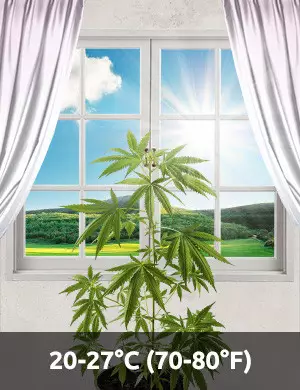
Leaf Curling In Cannabis Plants: Why It Happens, What Causes It, And How To Fix It
Last updated: 16 April 2021
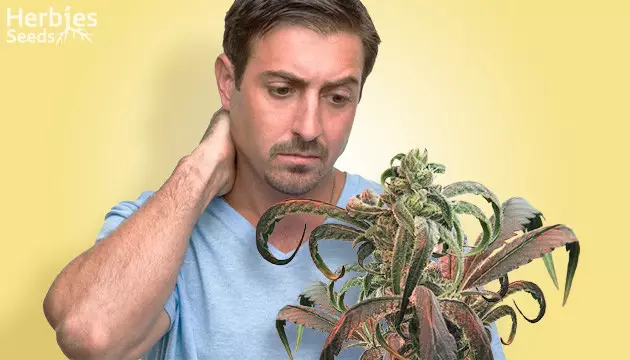
On a long enough timeline, every grower will see “the claw” – when leaves get droopy and begin to curl downward, you know something is wrong. Unfortunately, cannabis clawing can be a sign of numerous problems, all of which have different solutions. Even more confusingly, marijuana leaves can curl upward, too! In this post, we’ll cover all of the most common reasons for cannabis leaf curling and tell you how to deal with each of those problems.
Distinguishing Leaf Curling
Although “leaf curling” sounds like a simple enough symptom to diagnose, there’s more to it than you might expect. First, you’ll want to take note of whether your marijuana leaves curl down or up. Depending on the direction your leaves are curling in, it could signal one of several different problems beginning to develop.
Cannabis Health Problems Behind Curled Leaves
When you see the cannabis claw developing among the leaves in your garden, it’s just one symptom of the problem you may be facing. To solve the issue, you’ll need to identify other indicators of distress in your garden. We’ll include all kinds of problems that you should notice in our breakdown of the reasons behind marijuana clawing.
Cannabis Clawing Caused By Wind Burn
One common reason for marijuana leaves curling down is wind burn. Plants that receive wind that’s too powerful for too long will curl inward to protect themselves. Often, if wind burn is behind your leaves curling, you’ll also notice brown spots on your leaves that look like actual burns. You should also be able to see the airflow in your garden. If the curling is happening in a place with high airflow, the problem is probably wind burn.
How To Treat Wind Burn
Wind burn usually occurs when the fans in an indoor grow are blowing too intensely. If this is the case in your situation, the fix is simple: just turn down the fan’s intensity. If there’s no way to do that, consider changing the angle of the fan so it’s not hitting your plant directly. If you’re an outdoor grower who’s seeing wind burn, consider building some kind of windbreak around your plant.
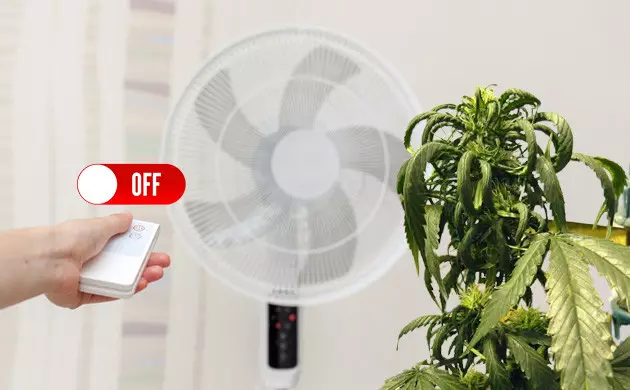
Marijuana Leaves Curling Down Due To Over/Underwatering
It might seem counter-intuitive, but both overwatering and underwatering can cause the cannabis claw to rear its ugly head. However, both of these problems cause different types of leaf curling. When a plant gets too much water, it fattens up, and it’s the extra weight that causes it to droop. Underwatering can also cause curling, but in this case, your media will be dry and your plants will perk up after you water them.
How To Fix Leaf Curl Caused By Overwatering/Underwatering
If you’re facing cannabis clawing caused by underwatering, the solution is pretty simple. Increase your watering schedule to make sure your media doesn’t dry out. This should solve the problem fairly quickly. For overwatering, you may need to do one of several things. First, you could decrease the amount of water you give to your plants every feed and/or feed them less frequently. It may also be a good idea to add pearlite to your medium in future grow cycles to help with the drainage.
Nitrogen Toxicity As A Reason Behind Cannabis Leaves Curling
While plants need nutrients to thrive, too much of a good thing can have the opposite effect. If you notice your marijuana leaves curling down in conjunction with a deep forest green hue to your leaves, you’re probably facing nitrogen toxicity, or overfertilization. Sometimes, excess nitrogen can occur even if you don’t change your nutrient mix. As plants mature, they require less nitrogen. As a result, marijuana plants don’t need the same level of nitrogen in the vegetative stage as they do in flowering.
How To Fix Nitrogen Toxicity In Cannabis Plants
Fortunately, if nitrogen toxicity is the reason behind your cannabis clawing, it’s an easy fix. First, flush your media with 6.0 pH water to get rid of any excess nutrients in your root zone. You should notice your plants begin to perk up in just a day or two. You also need to correct your feeding schedule. This should actually be easier than it sounds, since any respectable nutrient supplier will have a sample chart available for free on their website.
Bad Soil Also Causes Curly Weed
Bad soil can also cause cannabis clawing. Usually, you can tell if your soil is bad if it becomes wet, runny, and muddy. To assess the quality of your soil, consider three factors: texture, drainage, and water retention. Without good soil, your plants won’t be able to retain water, absorb nutrients, and maintain proper oxygen levels. Overwatering can lead to soil becoming bad, since constantly oversaturated soil will become muddy. Good soil will appear dark and have a loose texture.
How To Fix Bad Soil
Unfortunately, there’s little you can do once soil goes bad. Just try to let your medium drain properly to avoid exacerbating the problem. You can, however, prevent the problem in the future. Including pearlite or small rocks in your soil mix can help improve aeration and texture, keeping soil light and fluffy and assisting with drainage.
Damaged Roots And Twisted Cannabis Leaves
Root damage can also cause the claw. Root damage can cause weed leaves to curl either up or down. Many root problems are the result of overwatering. If you think you may have been overwatering your plants and curling continues even after you fix the problem, you may be facing damaged roots. Roots that get too hot or too cold for an extended period of time can also suffer damage. In this case, you may notice other symptoms along with curling such as blistered leaves.
Fixing Damaged Roots In Marijuana Plants
Unfortunately, once roots suffer damage, it can be difficult for them to bounce back. The best thing you can do is try to keep your plants healthy after they suffer damage, giving them the best chance to recover. Make sure your soil has proper drainage, correct any temperature imbalances, and let everything dry out between watering.
Cannabis Clawing Due To Root Rot
Similar to damaged roots, root rot is actually a term for any infection that attacks roots. If roots get too warm or develop an anaerobic environment (an environment without oxygen), pathogens like bacteria and fungi can infect them. These infections can prevent roots from absorbing nutrients and are a common reason behind twisted leaves in cannabis. If you’re facing root rot, you’ll see leaves turning down and developing brown patches. Root rot occurs most frequently in hydroponic systems. Your plant’s root system, if you can see it, will become goopy and brown instead of fresh, white, and happy.
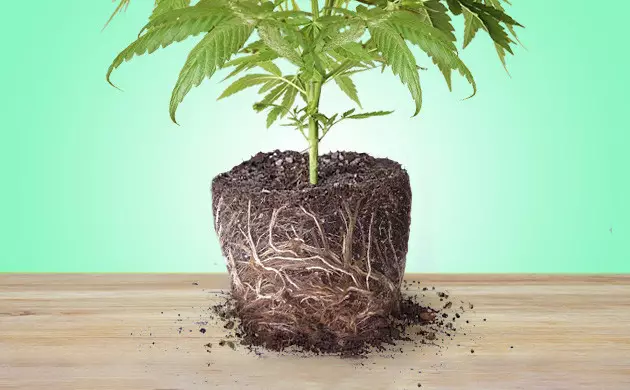
Solving Root Rot
Although many growers recommend H2O2 to solve root rot, this is only a temporary fix. It may appear to fix the problem for a few days, but eventually, it’ll come back. Instead, you can use a product from Botanicare called Hydroguard. Its main ingredient is a type of friendly bacteria that can out-compete the infection causing root rot. Our complete guide to healthy roots has more info on root rot.
Rootbound Cannabis Leaves Are Curling Too
If a plant becomes rootbound, it can also cause cannabis clawing. Plants can become rootbound if they’re kept in the same pot for too long. Once a root system runs out of room to grow, it’ll start curling in on itself and tie itself in knots. Eventually, roots will completely run out of room and choke itself. Rootbound plants will begin by drooping, then appearing to yellow and present root deficiencies.
Fixing Rootbound Cannabis Plants
The easiest way to fix a rootbound plant is to transplant it. To prevent plants from becoming rootbound in the first place, use air or fabric pots. These will allow air to touch the sides of your roots, which will kill them. This is called air-pruning, which can keep plants from getting rootbound for significantly longer than if you’d used a regular pot. If you want to learn more about this condition, we’ve outlined how to fix rootbound plants in another post.
Heat/Cold Stress Causing Cannabis Clawing
Incorrect environmental variables – temperatures that are either too high or too low – can also cause your leaves to curl. If you notice cannabis leaves curling upward, it can be an indication of heat stress. Eventually, the blades of your leaves will completely curl inward, like a taco shell. If a plant is cold, you’ll see curling as well as the colors of your leaves changing. Cold plants tend to turn purple or blue. This can help you determine whether you’re facing heat or cold stress instead of a different problem.
Solving Heat/Cold Stress
Luckily, if you’re seeing the cannabis claw developing from heat or cold stress, it’s fairly easy to fix. All you need to do is correct the temperature issue. First, check the temperature settings on your air conditioning. If it appears to be correct, consider increasing the airflow in your garden. Sometimes, air temperature in a garden isn’t uniform, so certain zones can be hotter or colder than others. Learn more about this in our guide to heat stress.


Cannabis Leaves Curling After Light Burn
One of the most common culprits behind twisted leaves in cannabis plants is light burn. Plants can still get light burn even if the temperature is completely under control. While it happens most often in indoor grows with artificial grow lamps, it can also happen outdoors from intense sunlight. To determine whether you’re facing light burn instead of another problem that causes leaf curling, look at where the clawing occurs. If it’s directly under your source of light, you’ve likely found your culprit.
Fixing Light Burn
While light burn is a fairly common cause of cannabis clawing, it’s also one of the easiest to fix. Simply increase the distance from your light source to the top of your canopy. For indoor gardens, try to raise your grow lights higher toward the ceiling. If that’s not possible, you may be able to use plant training techniques like LST to move your plant further from your light source. Learn more in our post on light burn.
Broad Mites As The Reason Behind Cannabis Clawing
Broad mites are a type of insect infestation that actually happens inside your weed plants. These types of infestations are fairly rare and also difficult to diagnose. That’s because mites are microscopic – so small you can’t see them with the naked eye. Plants will appear wet and blistered, along with the trademark cannabis claw being present. Broad mite infestations look similar to pH issues, heat stress, and overwatering.
Broad Mite Treatment
Broad mites are extremely difficult to get rid of and once an infection takes root, it’s almost impossible to stop. If you think you have a broad mite outbreak, check your plants under a microscope – you should see the little critters crawling around. If you do, remove any part of the plant affected by the infestation. It’s going to die anyway, and it’s best to remove it before the outbreak has a chance to spread. Then, spray your healthy plants with some kind of miticide (oil-based sprays work well). Arm yourself further with knowledge from our article on broad mites.
Hemp Russet Mites Is Why Marijuana Leaves Curl Down
Hemp russet mites are the bane of every cannabis grow. These microscopic bugs are so small that you can’t see them alone. By the time you notice hemp russet mites, there are already thousands of them crawling around your garden. First, you’ll notice your marijuana leaves inexplicably curling under themselves. Then, you’ll see orange dust beginning to appear. If your plants look like they’re covered with the dust at the bottom of a bag of Cheetos, you’ll know unequivocally that you’re facing hemp russet mites.
How To Get Rid Of Hemp Russet Mites
Hemp russet mites are extremely difficult to eradicate once an infestation takes hold. They lay their eggs inside your plants, making them virtually indestructible. They’re also highly resistant to most pesticides. In many situations, it’s a good idea to quarantine infested plants, removing them from your garden entirely to prevent them from spreading. You could also introduce predatory mites – specifically Amblysieus andersoni – into your garden. Make no mistake: this is one of the worst reasons for cannabis clawing.
Finally, if all else fails, there is a “nuclear option.” Spray your entire garden (including every separate room if you have more than one) with micronized sulfur. This will kill the infestation, although it will also ruin plants that are too late into the flower cycle.
Fungus Gnats And Cannabis Clawing
Fungus gnats are significantly less of a problem than hemp russet mites, but they can still cause curly weed. If you’ve ever seen tiny bugs flying around the top of your media, you’ve likely encountered these little bugs. A few fungus gnats flying around your grow generally aren’t a big deal. However, bigger infections can cause damage to your root system, which will manifest as the cannabis claw. Serious fungus gnat infestations can appear similar to other forms of root damage.
Fungus Gnat Treatment
Like most pathogens, fungus gnats like moist, dark areas. An outbreak usually occurs in plants that are overwatered. As a result, one way to get rid of fungus gnats is to reduce the amount you’re watering your plants. In addition, there are several ways to control an infestation after it happens. First, you can use yellow bug traps to catch fungus gnats. You can also use pesticides like neem oil to chemically attack an outbreak and resolve your cannabis clawing. Learn more about fungus gnats here.
Leave Curling In The Dust
We’ve covered a lot of information in this post. It’ll likely take a little bit of time to digest and understand, but the main thing you need to keep in mind when diagnosing the source of curling leaves is to check for secondary symptoms. Chances are, curling leaves aren’t the only problem your plant is facing, so check for more symptoms to deduce what exactly is ailing your garden.
Herbies Head Shop expressly refuses to support the use, production, or supply of illegal substances. For more details read our Legal Disclaimer.
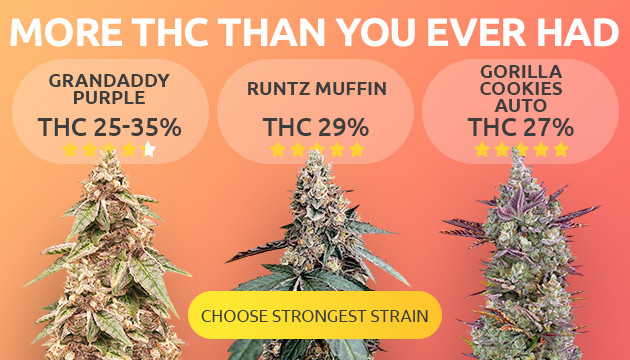
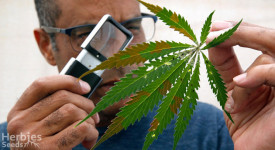
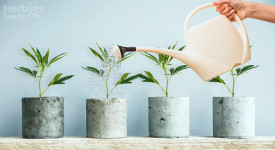

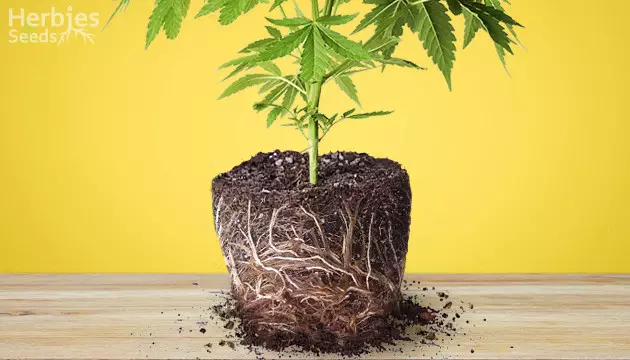
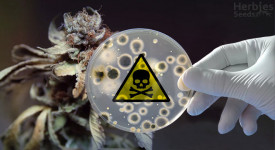









Thank you for leaving a comment for us!
Your feedback will be posted shortly after our moderator checks it.
Please note that we don’t publish reviews that: